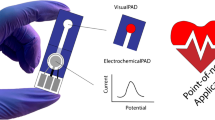Abstract
Determination of the pH value of the paper is a very specific phenomenon, especially the surface pH measurement. In the case of heritage objects, such as archival documents, books, artworks on paper carriers, is a determination of real pH value in the whole structure (in cross section) of paper very important, because of the mechanism of degradation and thus the rate of degradation of the paper components at a given point in the paper structure depends on the pH value in the environment. This paper is aimed to show the possibilities of using modified papers by acid–base indicator, in the field of measurement of pH value of paper in the cross section of the paper. A calibration series of acidic samples neutralizing by magnesium bicarbonate of different concentrations was created. It was found that the indicator changed in the desired area, pH value 6–8, and it was observed gradual color change. The color parameters were measured and the most correlated parameter with pH value was found. The new method enables the observation of pH distribution in a critical cross section of modified paper after deacidification processes.




Similar content being viewed by others
Abbreviations
- CIELAB space:
-
CIE L*a*b* − a color space defined by the International Commission on Illumination (CIE) in 1976
- µ*pH:
-
Micro-pH distribution
- pH-CP:
-
PH characteristic parameters
- RH:
-
Relative humidity
References
J.W. Baty, C.L. Maitland, W. Minter, M.A. Hubbe, S.K. Jordan-Mowery, BioResources 5, 3 (2010)
T. Allscher, I. Ceynowa, ABI Technik. 38, 1 (2018). https://doi.org/10.1515/abitech-2018-0004
D. Klemm, B. Philipp, T. Heinze, U. Heinze, W. Wagenknecht, Compr. Cell. Chem. (1998)
P.M. Whitmore, J. Bogaard, Restaurator 15, 26 (1994)
M. Ďurovič, Restaurování a Konzervování Archiválií a Knih, 1st edn. (Praha, Paseka, 2002), pp. 213–218
A.S. Zervos, Cellulose (2015). https://doi.org/10.1007/s10570-015-0699-7
A. Potthast, K. Ahn, Cellulose 24, 1 (2017)
S. Buchanan et al., An evaluation of the Bookkeeper mass deacidification process. Pittsburgh: Library of Congress, https://www.loc.gov/preservation/resources/rt/bookkeeper.pdf. Accessed 6 Nov 2020
A. Lienardy, Restaurator 15, 1 (1994)
J. Hanus et al., Evaluation of Some Deacidification Processes (National Archive, Prague, 2007).
M. Ramin, H. Andres, A. Blüher, M. Reist, M. Wälchli, J. Pap, Conserv. 10, 3 (2009)
S. Katuscak, M. Jablonsky, S. Holubkova, Z Bibl. Bibl. 106, 149–176 (2012)
S. Katuscak, B. Dušan, J. Šima, A. Urlandová, Knižnica 6, 4–9 (2008)
S. Katuščák et. al. Project Kniha SK. http://www.knihask.eu
K. Ahn, Sustainability of mass deacidification of library objects. Diss. PhD Thesis, Universität für Bodenkultur, Wien (2013)
M. Hubbe et al., BioResources 12, 2 (2017). https://doi.org/10.15376/biores.12.2.4410-4477
P. G. Sparks, Technical considerations in choosing mass deacidification processes. Report of the Commission on Preservation and Access (1990)
A. Pothast, U. Henniges, ABI Technik. (2016). https://doi.org/10.1007/s10570-013-9978-3
L. Van der Schueren, K. De Clerck, Text. Res. J (2010). https://doi.org/10.1177/0040517509346443
L. Van der Schueren et al., Sensor Actuator B-Chem. 162, 1 (2012). https://doi.org/10.1016/j.snb.2011.11.077
H.Z. Chen, M. Zhang, B. Bhandari, Z. Guo, Postharvest. Biol. Technol. 140, 85–92 (2018)
B. Kuswandi, A. Nurfawaidi, Food Control 82, 91–100 (2017)
K. Vizárová, I. Vajová, R. Tiňo, Z. Takáč, N. Krivoňáková, Š. Vodný, S. Katuscak, Orthogonal and Cylindrical Color Parameters for Colorimetric pH Measurement of Materials and Objects, work in progress
S. Katuscak, S. Vodný, K. Vizárová. Method and apparatus for pH distribution measurement in porous material microstructure. Patent Appl.: 62/392456 (2016)
I. Bruckle, Structur und Eigenschaften von trockenem und nassem Papier. In Papier und Wasser, ed. By G. Banik, I. Bruckle (Siegel, Munich, 2015)
KLUG-Conservation, Quality Description Novo test paper – wood-containing, viewed on 10 June 2017, http://www.klug-conservation.com/?site=produkte&id=151&pi=
Acknowledgements
The authors gratefully acknowledge financial support from the Slovak Agency for Research and Development (APVV) (Project 18-0155 MUFUSCEM) and Certex a.s.
Author information
Authors and Affiliations
Corresponding author
Additional information
Focus Point on Scientific Research in Cultural Heritage.
Rights and permissions
About this article
Cite this article
Vajová, I., Vizárová, K., Tiňo, R. et al. Determination of pH distribution through pH-related properties in deacidified model paper. Eur. Phys. J. Plus 136, 578 (2021). https://doi.org/10.1140/epjp/s13360-021-01495-9
Received:
Accepted:
Published:
DOI: https://doi.org/10.1140/epjp/s13360-021-01495-9




